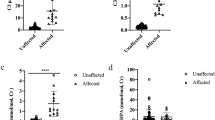Summary
Acylcarnitines were assayed in amniotic fluid by isotope dilution tandem mass spectrometry. Control values for propionylcarnitine, C4 and C5 acylcarnitines were established. Propionylcarnitine was elevated by a factor of 5 relative to controls in the amniotic fluid of three pregnancies affected with propionic acidaemia. This may provide a convenient new method for prenatal diagnosis of propionic acidaemia. One pregnancy at risk for propionic acidaemia but unaffected according to methylcitrate analysis had an intermediate level of propionylcarnitine, indicating the need for further studies to determine the range of concentration in probable heterozygotes.
Similar content being viewed by others
References
Bohmer T, Bremer J (1968) Propionylcarnitine, physiological variations in vivo.Biochim Biophys Acta 152: 559–567.
Buchanan PD, Kahler SG, Sweetman L, Nyhan WL (1980) Pitfalls in the prenatal diagnosis of propionic acidaemia.Clin Genet 18: 177–183.
Chadefaux B, Augereau C, Rabier D et al (1988) Prenatal diagnosis of propionic acidemia in chorionic villi by direct assay of propionyl CoA carboxylase.Prenat Diagn 8: 161–164.
Chalmers RA, Roe CR, Stacey TE, Hoppel CL (1984) Urinary excretion ofl-carnitine and acylcarnitines by patients with disorders of organic acid metabolism: evidence for secondary insufficiency ofl-carnitine.Pediatr Res 18: 1325–1328.
Coude M, Chadefaux B, Rabier D, Kamoun P (1990) Early amniocentesis and amniotic fluid organic acid levels in the prenatal diagnosis of organic acidemias.Clin Chim Acta 187: 329–332.
Gompertz D, Goodey PA, Thom H et al (1975) Prenatal diagnosis and family studies in a case of propionic acidemia.Clin Genet 8: 244–250.
Holm J, Ponders L, Sweetman L (1989) Prenatal diagnosis of propionic and methylmalonic acidaemia by stable isotope dilution analysis of amniotic fluid.J Inher Metab Dis 12: 271–273.
Jakobs C, Ten Brink HJ, Stellaard F (1990) Prenatal diagnosis of inherited metabolic disorders by quantitation of characteristic metabolites in amniotic fluid: facts and future.Prenat Diagn 10: 265–271.
Millington DS, Maltby DA, Roe CR (1984) Application of high resolution fast atom bombardment and constant B/E ratio linked scanning to the identification and analysis of acylcarnitines in metabolic disease.Biomed Mass Spectrom 11: 236–241.
Millington DS, Maltby DA, Gale D, Roe CR (1989) Synthesis and human applications of stable isotope-labelledl-carnitine. In Baillie TA, Jones JR, eds.Synthesis and Application of Stable Isotopically Labelled Compounds 1988. Amsterdam: Elsevier, 189–194.
Millington DS, Kodo N, Roe CR (1990) Tandem mass spectrometry: a new method for acylcarnitine profiling with potential for neonatal screening for inborn errors of metabolism.J Inher Metab Dis 13: 321–324.
Millington DS, Kodo N, Terada N, Roe D, Chace DH (1991) The analysis of diagnostic markers of genetic disorders in human blood and urine using tandem mass spectrometry with liquid secondary ion mass spectrometry.Int J Mass Spectrom Ion Processes 111: 211–228.
Naylor G, Sweetman L, Nyhan WL et al (1980) Isotope dilution analysis of methylcitric acid in amniotic fluid for the prenatal diagnosis of propionic and methylmalonic acidemia.Clin Chim Acta 107: 175–183.
Penn D, Schmidt-Sommerfeld E, Jakobs C, Bieber LL (1987) Amniotic fluid propionylcarnitine in methylmalonic aciduria.J Inher Metab Dis 10: 376–382.
Roe CR, Bohan TP (1982)l-Carnitine therapy in propionic acidaemia.Lancet,1: 1411–1412.
Roe CR, Millington DS, Maltby DA, Bohan TP (1984)l-Carnitine enhances excretion of propionyl coenzyme A as propionylcarnitine in propionic acidemia.J Clin Invest 73: 1785–1788.
Roe DS, Terada N, Millington DS (1992) Automated analysis of free and total carnitine in plasma using a COBAS FARA II centrifugal analyzer.Clin Chem 38: 2215–2220.
Sugiyama N, Kidouchi K, Kobayashi M, Wada Y (1990) Carnitine deficiency in inherited disorders and Reye syndrome.Acta Paediatr Jap 32: 410–416.
Sweetman L, Weyler W, Shafai T, Young PE, Nyhan WL (1979) Prenatal diagnosis of propionic acidemia.J Am Med Soc 242: 1048–1052.
Tahara T, Kraus JP, Rosenberg LE (1990) An unusual insertion/deletion in the gene encoding the β-subunit of propionyl-CoA carboxylase is a frequent mutation in Caucasian propionic acidemia.Proc Natl Acad Sci USA 87: 1372–1376.
Author information
Authors and Affiliations
Rights and permissions
About this article
Cite this article
Van Hove, J.L.K., Chace, D.H., Kahler, S.G. et al. Acylcarnitines in amniotic fluid: Application to the prenatal diagnosis of propionic acidaemia. J Inherit Metab Dis 16, 361–367 (1993). https://doi.org/10.1007/BF00710283
Received:
Accepted:
Issue Date:
DOI: https://doi.org/10.1007/BF00710283




